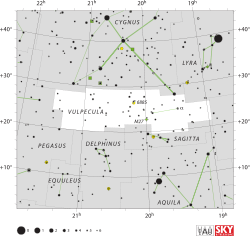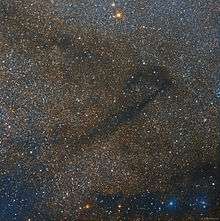Alpha Vulpeculae
 | |
| Observation data Epoch J2000.0 Equinox J2000.0 | |
|---|---|
| Constellation | Vulpecula |
| Right ascension | 19h 28m 42.330s[1] |
| Declination | +24° 39′ 53.65″[1] |
| Apparent magnitude (V) | 4.40[2] |
| Characteristics | |
| Spectral type | M1 III[3] |
| B−V color index | 1.487[4] |
| Variable type | +1.81[2] |
| Astrometry | |
| Radial velocity (Rv) | −84.91 ± 0.26[4] km/s |
| Proper motion (μ) | RA: –126.13 ± 0.19[1] mas/yr Dec.: –107.44 ± 0.22[1] mas/yr |
| Parallax (π) | 10.97 ± 0.28[1] mas |
| Distance | 297 ± 8 ly (91 ± 2 pc) |
| Absolute magnitude (MV) | −0.36[5] |
| Details | |
| Radius | 42[4] R☉ |
| Luminosity | 400[4] L☉ |
| Surface gravity (log g) | 1.5[4] cgs |
| Temperature | 3,990[4] K |
| Rotational velocity (v sin i) | 4.6[4] km/s |
| Other designations | |
| Database references | |
| SIMBAD | data |

Alpha Vulpeculae (α Vulpeculae, abbreviated Alf Vul, α Vul), also named Anser,[8] is the brightest star in the constellation of Vulpecula. It is approximately 297 light-years from Earth. It forms a wide optical binary with 8 Vulpeculae.[9]
Alpha Vulpeculae is a red giant of spectral class M1 and has apparent magnitude +4.4. It has been analysed as a member of the Arcturus stream, a group of stars with high proper motion and metal-poor properties thought to be the remnants of a small galaxy consumed by the Milky Way.[10]
Nomenclature
α Vulpeculae (Latinised to Alpha Vulpeculae) is the system's Bayer designation.
It bore the traditional name Anser, derived from when the constellation had the name Vulpecula cum Ansere 'the little fox with the goose'.[6] In 2016, the IAU organized a Working Group on Star Names (WGSN)[11] to catalog and standardize proper names for stars. The WGSN approved the name Anser for this star on 30 June 2017 and it is now so included in the List of IAU-approved Star Names.[8]
References
- 1 2 3 4 5 van Leeuwen, F. (2007). "Validation of the new Hipparcos reduction". Astronomy and Astrophysics. 474 (2): 653–664. arXiv:0708.1752. Bibcode:2007A&A...474..653V. doi:10.1051/0004-6361:20078357. Vizier catalog entry
- 1 2 Mermilliod, J.-C. (1986), "Compilation of Eggen's UBV data, transformed to UBV (unpublished)", Catalogue of Eggen's UBV data. SIMBAD, Bibcode:1986EgUBV........0M.
- ↑ Morgan, W. W.; Keenan, P. C. (1973), "Spectral Classification", Annual Review of Astronomy and Astrophysics, 11: 29, Bibcode:1973ARA&A..11...29M, doi:10.1146/annurev.aa.11.090173.000333.
- 1 2 3 4 5 6 7 Massarotti, Alessandro; et al. (January 2008), "Rotational and radial velocities for a sample of 761 HIPPARCOS giants and the role of binarity", The Astronomical Journal, 135 (1): 209–231, Bibcode:2008AJ....135..209M, doi:10.1088/0004-6256/135/1/209.
- ↑ Anderson, E.; Francis, Ch. (2012), "XHIP: An extended hipparcos compilation", Astronomy Letters, 38 (5): 331, arXiv:1108.4971, Bibcode:2012AstL...38..331A, doi:10.1134/S1063773712050015.
- 1 2 Barentine, John C. (2016). "Anser". The Lost Constellations. p. 35. doi:10.1007/978-3-319-22795-5_3. ISBN 978-3-319-22794-8.
- ↑ "HD 20781". SIMBAD. Centre de données astronomiques de Strasbourg. Retrieved 2014-09-13.
- 1 2 "Naming Stars". IAU.org. Retrieved 16 December 2017.
- ↑ "Washington Double Star Catalog". United States Naval Observatory. Archived from the original on 2011-02-14. Retrieved 17 January 2018.
- ↑ Eggen, Olin (1971). "The Arcturus Group". Publications of the Astronomical Society of the Pacific. 83 (493): 271–85. Bibcode:1971PASP...83..271E. doi:10.1086/129120.
- ↑ "IAU Working Group on Star Names (WGSN)". Retrieved 22 May 2016.